COTTLE 僕が思う一つの魅力 / On One of COTTLE’s Beauties
2025.8.2
これまでもお知らせしていましたが、現在、COTTLEの国内展示会および、一般の方向けのオーダー形式の販売イベントを開催しています。
一般の方向けには、先日の月曜日からスタートしていることもあり、明日、明後日の最後の2日間が土日ということで、ご都合の合う方は、是非ともCOTTLEを見てみてもらえたらと思います。
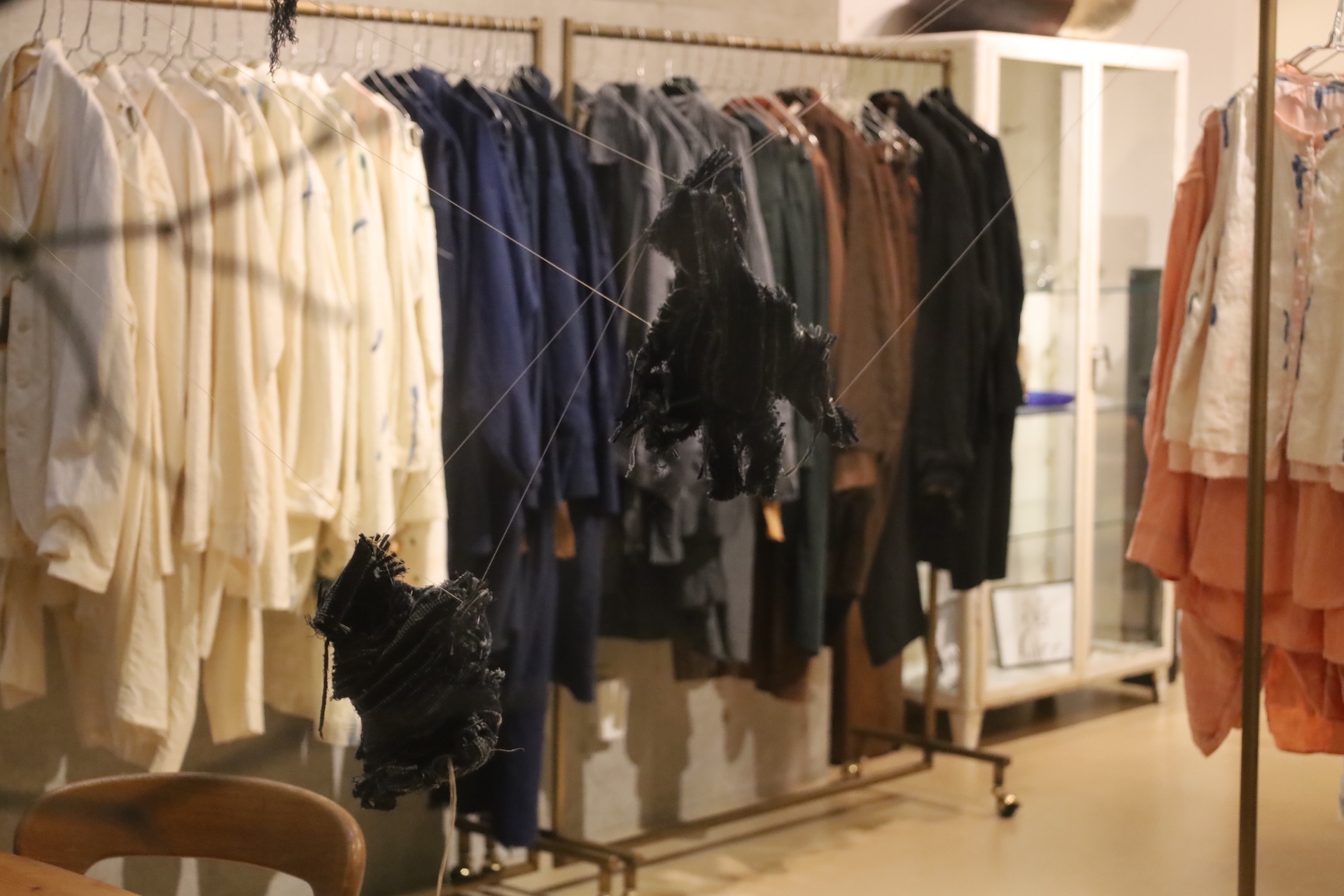
これまでこのshop talk内では、何度かCOTTLEについて記載をしてきましたが、とてもコレクションの規模が大きいブランドであるため、今まで書いたことではまだまだCOTTLEのコレクションについては網羅できません。
しかしながら、COTTLEのオフィシャルページにも、コレクションについて”Dictionary”という項目で、とても素敵で詳細な内容が記載されていますので、そちらをご覧頂くのがすごく良いと思います。
僕自身は、古巣セレクトショップで、4年程前からCOTTLEを販売していたことや、自分でも普段からよく身につけていることもあり、様々にその良さを感じています。
だから、今回は僕が自分なりに感じているCOTTLEの魅力の一つの部分を紹介させて頂きます。
それが、これ。
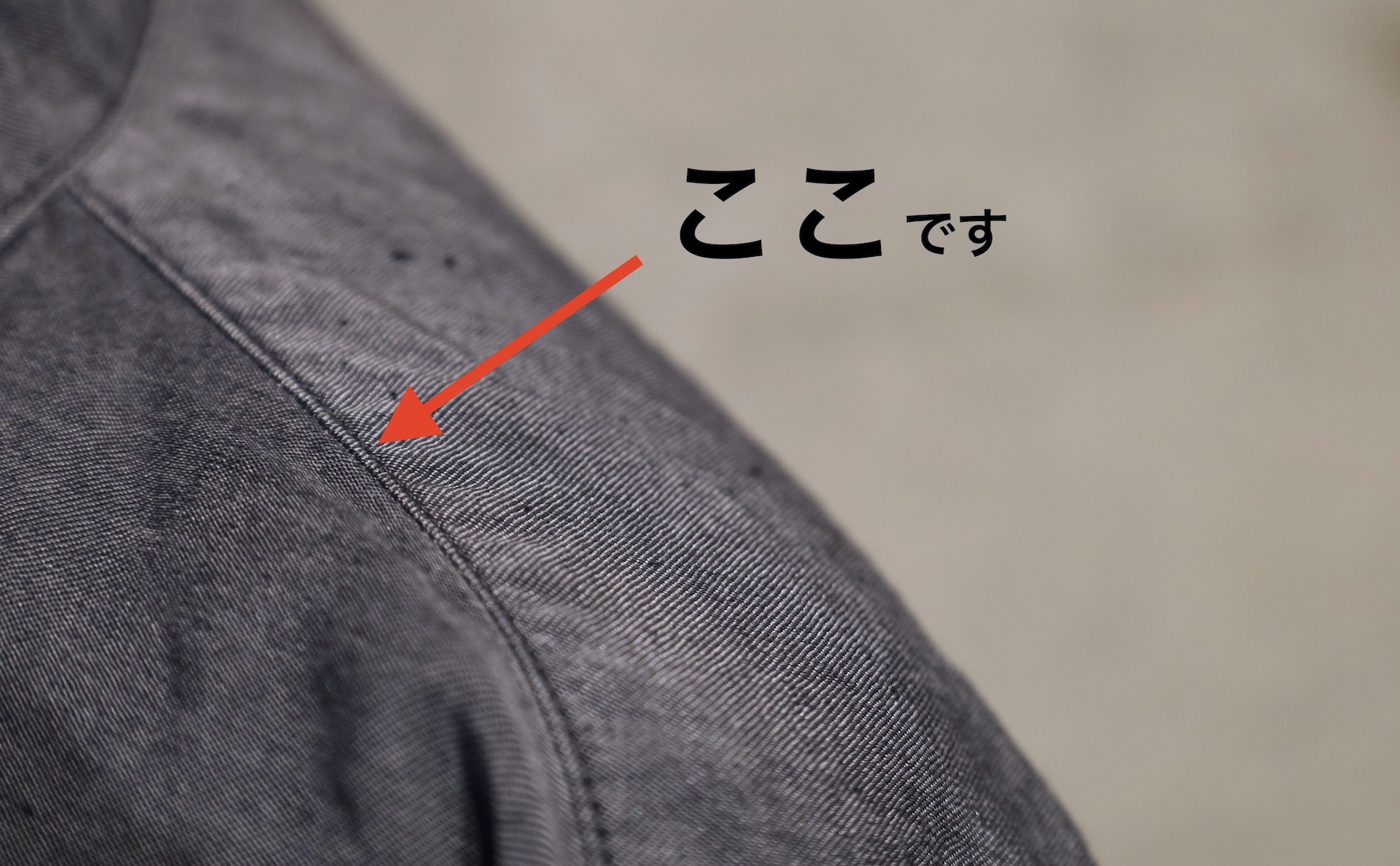
“生地端からステッチまでの幅の細さ”である。
この部分にとても魅力を感じ続けています。
具体的に言うと、この箇所は折り伏せ縫い。
折り伏せ縫いを施す場合には、一般的な数値は、服の箇所にもよるのですが、生地端から5ミリ幅とか、8ミリ幅、10ミリ幅など服の部分によって変わります。
しかし、COTTLEの場合には、この折り伏せ縫いの生地端からの距離は、多くの場合、他の服の半分ほどの細さであると思います。
自分たちで洋服の設計を行ない、岡山の自社の縫製工場でサンプルをつくり、同じ場所で実際の商品もつくる。
以前に、COTTLEの渡辺さんが言っていたことがあるのですが、設計段階やサンプル段階で仕様などのディテールが決まっていても、製作を進めていく段階で、より良い方法が自分たちの中で見つかることがある。
そうなると、すぐに軌道修正したり、一層のレベルアップをすることができると。
そのように続けているから、今の縫製の現場では、なかなか実現困難なディテールがたくさんあり、今回取り上げている”生地端から縫い代までの幅の細さ”も、その内の一つ。
でも、大前提として、服というものは、”ただ縫い代が細く、運針が細かいのが最良である”ということではありません。
要するに「細かければ良い」ということではない。
しかし、現実として、洋服づくりを行なう人々や、洋服業界の人が、このような”「細かければ良い」ということではない。”という言葉に甘んじて、ある種、そのような”高み”とも言えることにトライしなくなっている現状が事実としてあるとは感じています。
また、生地端から縫い代までの幅が細かったり、運針が細かいことで、ふんわりしたような生地や、薄手で、柔らかいことが最大の強みである生地の場合には、縫い代が固くなってしまい、推しポイントが半減してしまうというデメリットはあります。
対して、COTTLEは、”日々の生活で使用する”という「民藝」の考え方をブランドの重要な思想としてる。
そのため、例えば、今回のshop talkで、実際に撮影している”LEAF VEIN (葉脈)”など、エゲツないほどに丈夫な生地を開発しています。
そのような非常に耐久性に富んだ生地であるため、どちらかというと、ふんわり柔らかく仕上げる縫製というよりも、”とにかく細かく細かく手を尽くしている縫製”です。
その一つの現れとして、“生地端からステッチまでの幅の細さ”が際立っていると感じています。
僕は、凝ってるもの・細かいもの・複雑なものが好きなのですが、COTTLEの洋服は、一着を隅々まで見渡しても、まさにそのようなもの。

今回撮影したものは、LEAF VEINのTAILOR MADE SHIRTというもの。
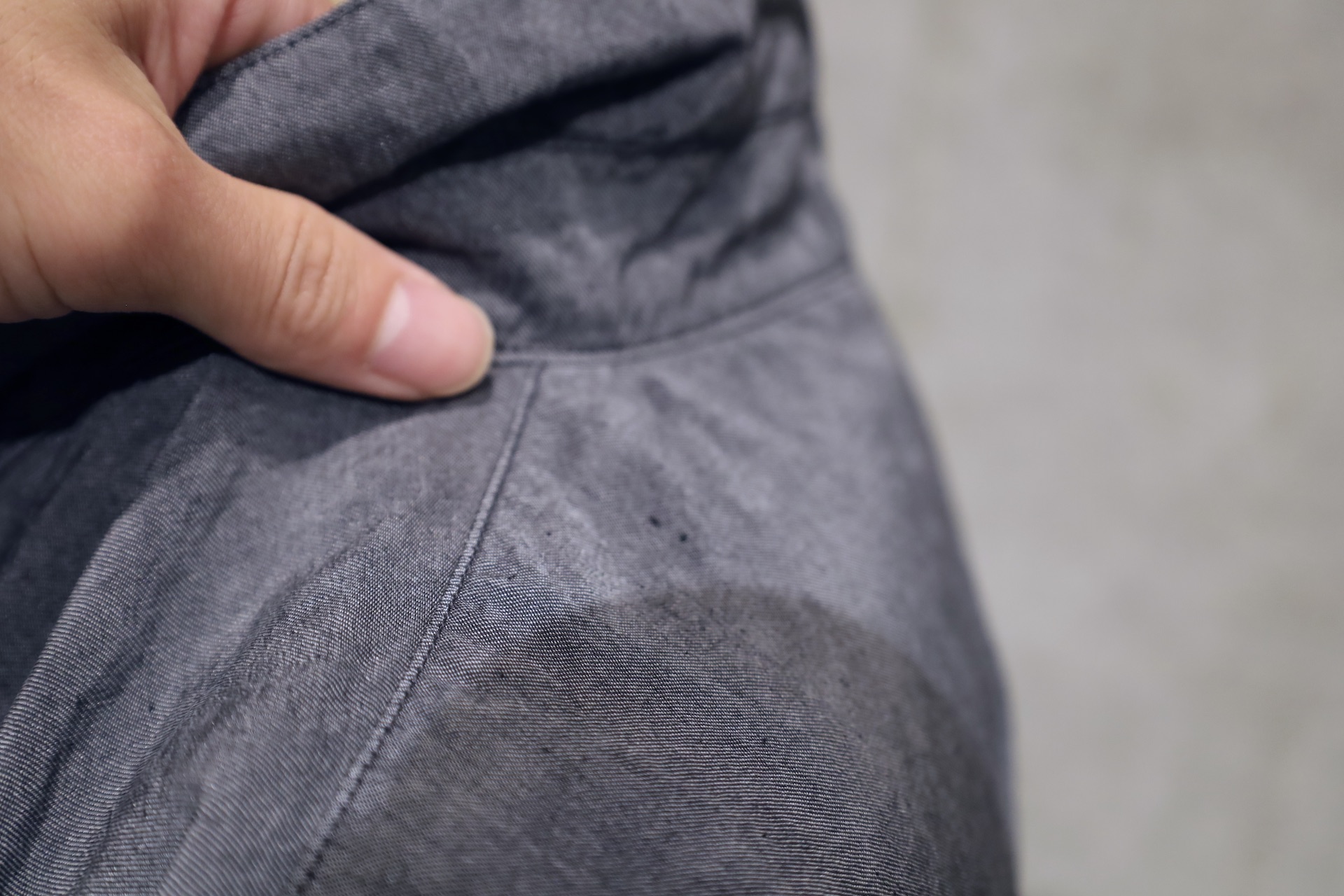
前身頃とヨークの切り替えの折り伏せ縫い、生地端まで約2ミリ。

こちらは無染色のもの。

アームホールの折り伏せ縫い、生地端までの幅、約4ミリ。
ものによって3ミリ幅もある。
この箇所は、通常であれば大体7ミリ〜10ミリになる部分だと思うので、COTTLEでは約半分以下を攻めている。
僕は、COTTLEのシャツ類では、このアームホールの生地端からのステッチ幅が、特に感激ポイントです。
その理由は、ウラにも。。。
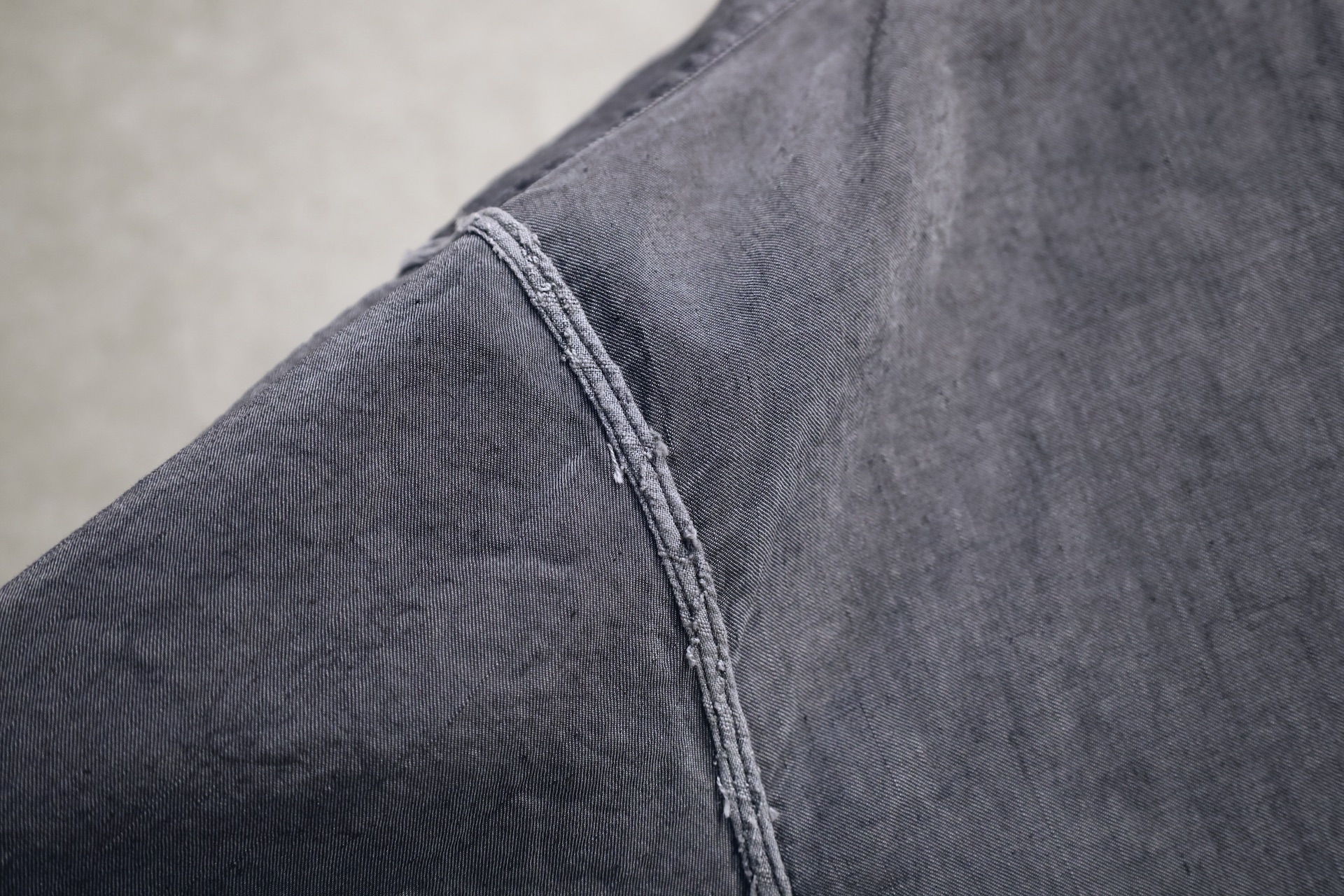
アームホールの裏には、民藝思想から滋賀県で生まれたとされる”幻の織物”。
ヒゲつむぎという生地を継承したパイピングが施されています。
パターン上、身頃と袖の生地が反対側にカーブをする形状のアームホール箇所を、それだけの細幅の折り伏せ仕様で縫い上げることは、それだけでもとてもハードルが高いことです。
それにも関わらず、ヒゲつむぎのパイピングを加えた上で、その縫い代幅を実現していることは、ホンットすごいこと。
そして、このヒゲつむぎのパイピングが加わることで、アームホールの折り伏せ縫いが、立体的に浮かび上がるように僕は感じます。
そういうところに、とてつもなく美しさを感じるのです。僕は。
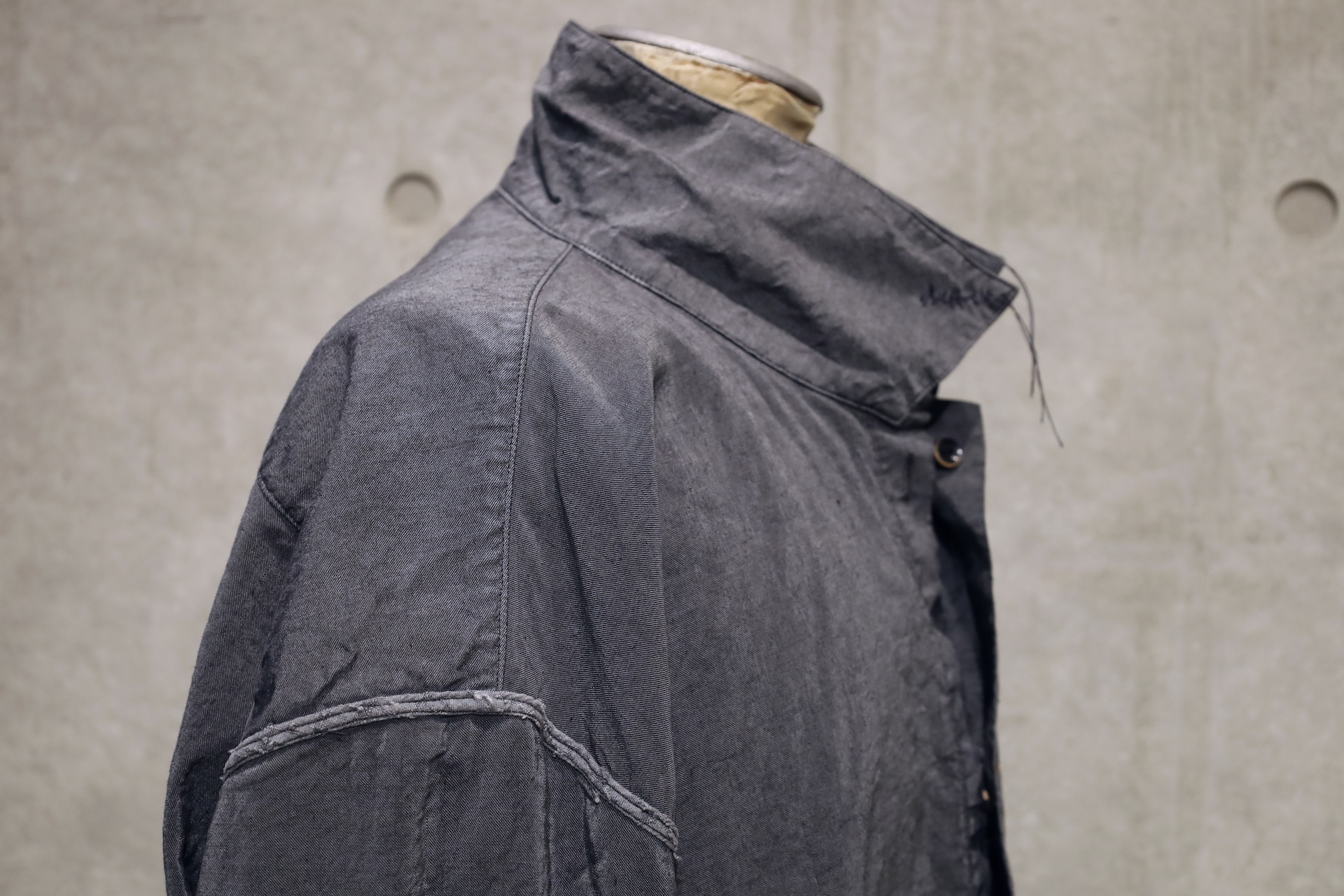
こちらも裏から見た様子。
先述のアームホールや、身頃とヨークの切り替えの折り伏せ幅、衿付けの幅なども、見事に細い。
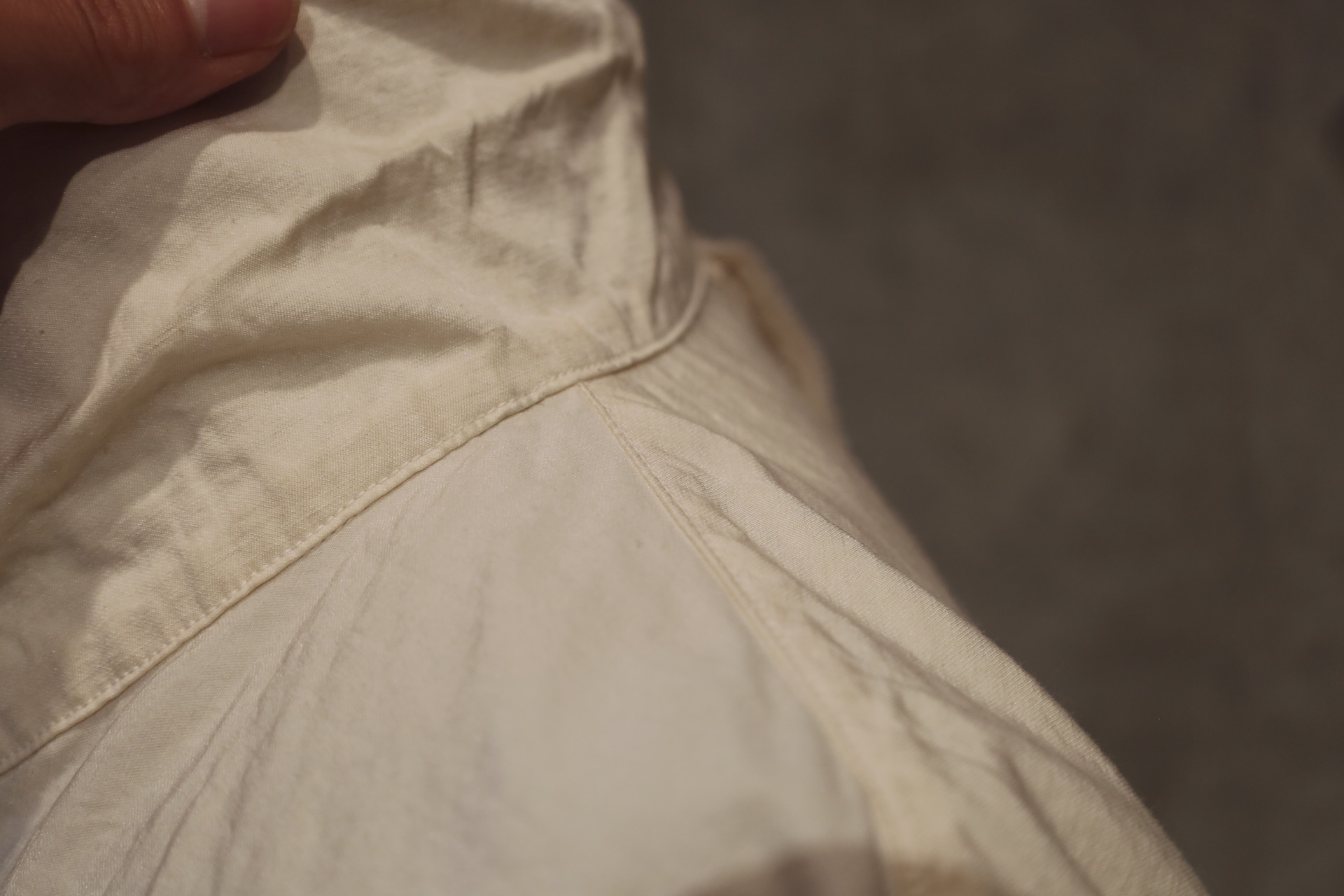
細い。
感激。

こちらも同様に裏側のバックヨークと後身頃の切り替え。
以前にEARTH WALLの生地について記載をした時に、LEAF VEINの生地は、厚みが0.41ミリ(シャツジャケットくらいの厚み)であると載せたことがありました。
それくらい厚みのある生地なのにも関わらず、ギャザーが集まる箇所でも、丁寧に上手く縫われる。
しかも、この写真、ポイントは”裏側”である。ということ。
通常は表側から縫うため、裏は目視できず、糸目も歪みやすいのですが、細い縫い代のまま裏側も縫い上げているのには、本当に感心させられます。
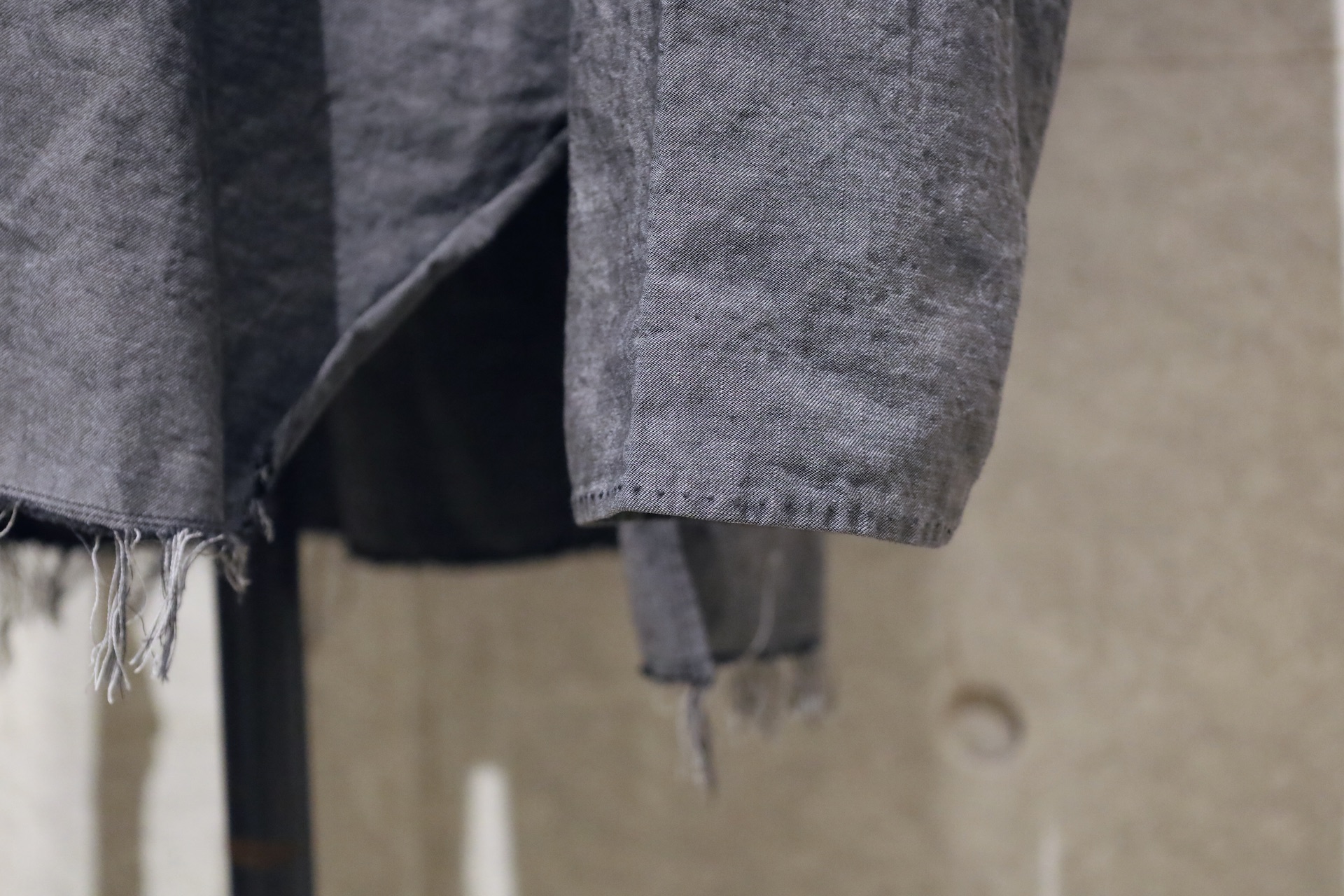
対して、こちらは袖口。
今回は、皆様にCOTTLEの”生地端からステッチまでの幅の細さ”を一番に伝えたいので、あまり別のことには触れないようにしていますが、COTTLEの凄みは、ただただ頑丈につくっているのではなく、一着の洋服の中で、それぞれのディテールに対して、ブランドの思想が行き届いているように思います。
袖口は、シャツであればシャツカフスをつけるのがセオリーであるところ、生地端を三つ折りにして、手まつりを施した仕様です。
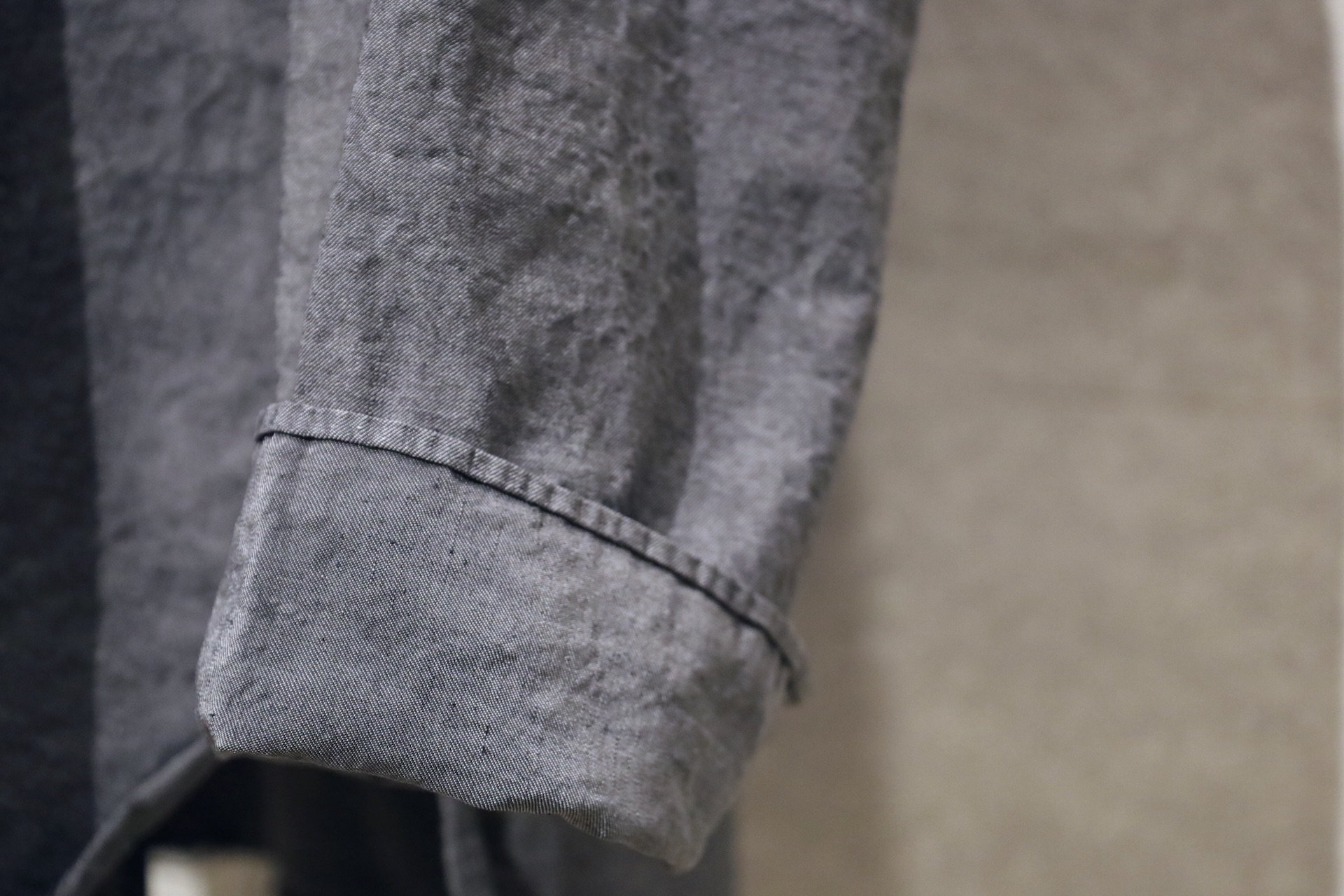
シャツは袖口を捲ったり、折り返して着用される方もいると思います。
この設計により、袖口を折り返した際に生地が柔らかく肌にあたり、とても心地良さを感じることができる仕様です。
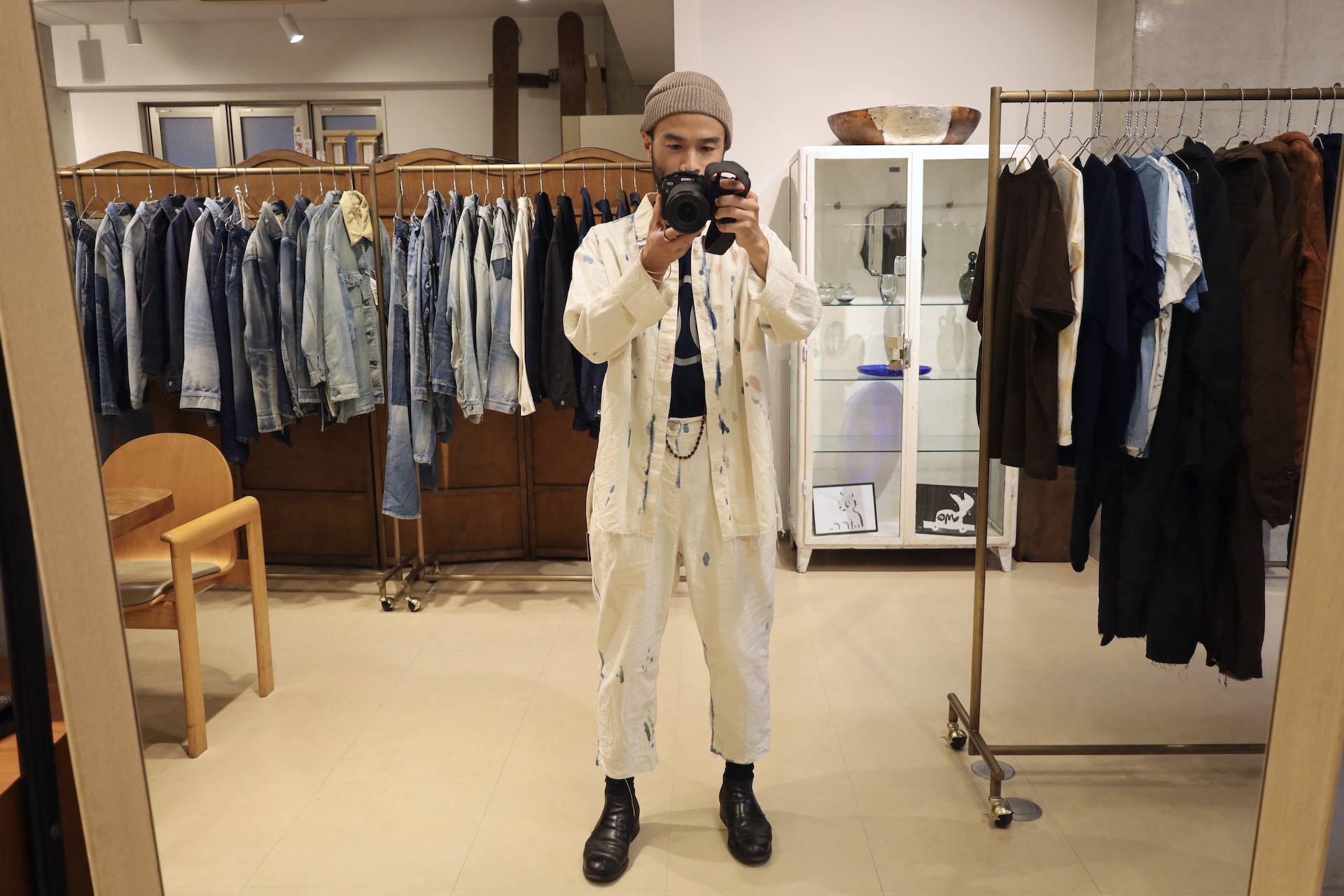
そして、本日の僕。
以前の販売員時代から好きで着ている、LEAF VEINのFERMENTATION(発酵)というカラーリングのセットアップ。
上はTAILOR MADE SHIRTで、4年かな?くらい着て、首裏に汚れが付着するのがあまり好きではないので、ハンパないほど洗濯もして、余裕で300回は洗ってるんじゃないかと思いますが、生地も構造も全然ダメにならない。
あまりにもたくさん着ているので、COTTLEの渡辺さんにお願いをして、FERMENTATIONの再染色もしてもらっているほど、着続けているのですが、自分にとっては嫌な要素を一つも感じない洋服で、その凄さをよく体感しています。
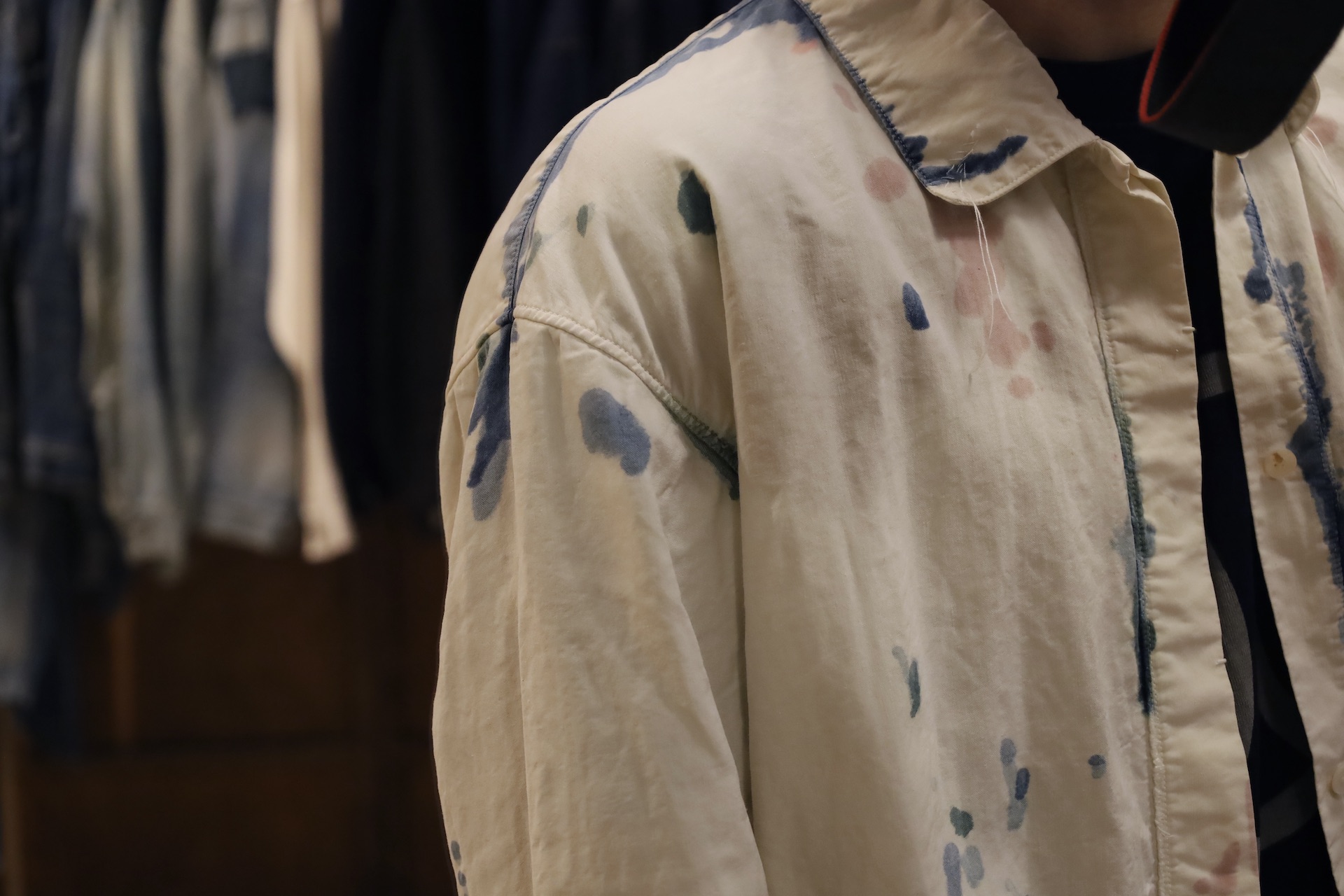
そして、実際に着ていると、この写真わかりますでしょうか。
アームホールの折り伏せ縫いの幅の細さ。
着てしまうと全然気付かない。と言われてしまうような部分ではあると思いますが、このようなディテールも一つの大事な要素。
仮に気付かなくとも、一着の洋服はこのような細部の集積で出来上がっているもの。
そして、そのようなことを大切に、自社の縫製工場での洋服づくりを続けるCOTTLEの魅力。
そのことを明確に感じられる事柄だと思います。
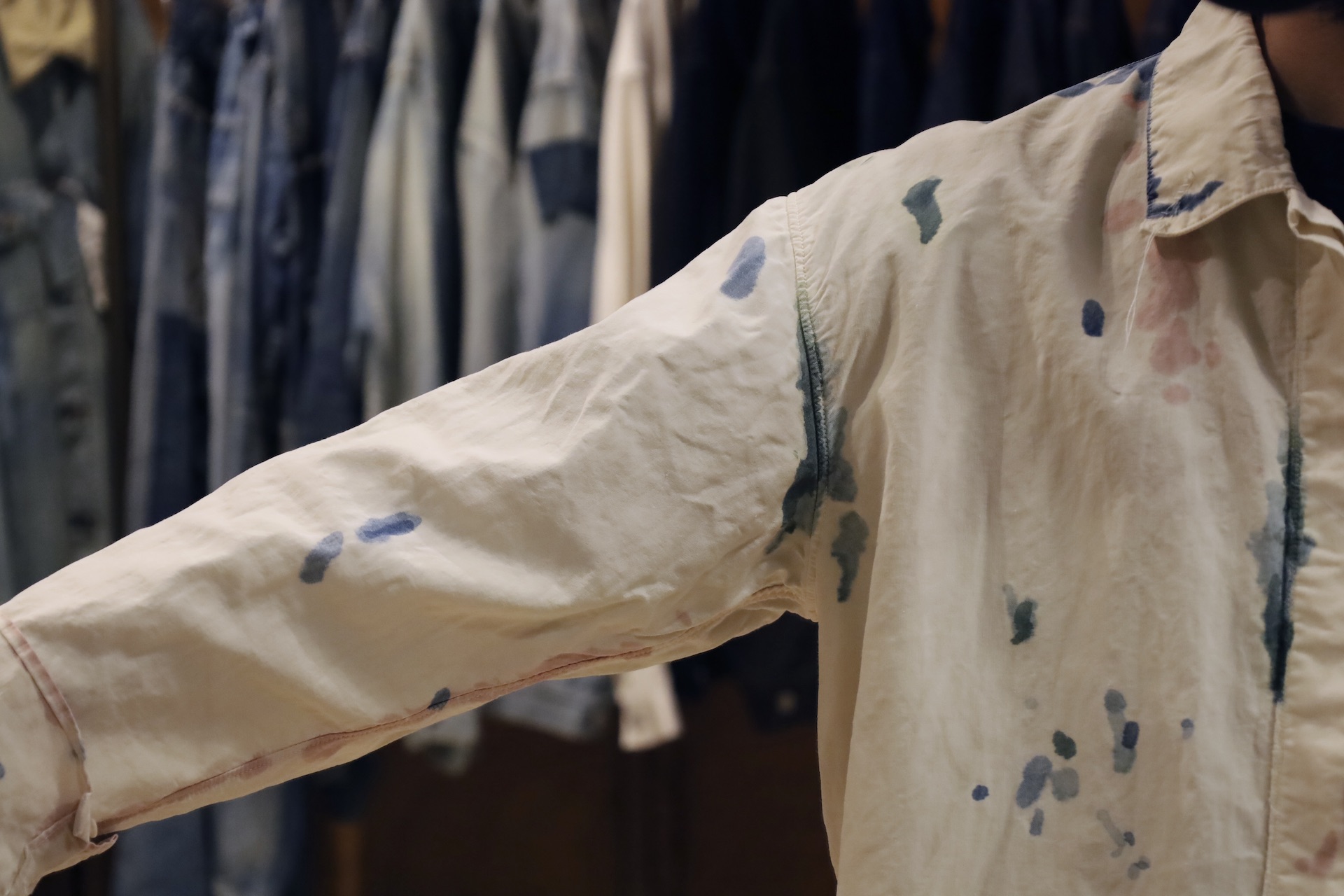

どんな洋服でも、ほぼ必ず行われる縫製。
でも、最も目を向けられにくい部分であると思います。
“縫製”というのは、誰が縫うのかで服は全然違うものが出来上がるし、”技術職”というくらいだから、ちゃんと向き合われて縫われた洋服には、その技術が宿ると僕は常々思っています。
今回、この内容のshop talkを書くことにしたのは、代表の秋吉に「福ちゃんはCOTTLEの偏愛ポイントってなんなの?」と言われたことで、僕の頭の中で真っ先に浮かんだのが”生地端からステッチまでの幅が細いこと”でした。笑
COTTLEには、いろんな良いところがあるのですが、今日は僕の偏愛ポイントの一つを紹介させてもらいました。
この土日まで、アポイント不要でどなた様にもご覧頂けますので、ご興味がある方は是非見てみてください。
LE BERGER / Herd Limited.
shop talk & communications by Akihiko Fukuda
__________
The English translation is provided below:
As we’ve mentioned before, COTTLE is currently hosting both a domestic exhibition and a made-to-order sales event open to the general public.
Since the public event started this past Monday, the final two days fall on the weekend—Saturday and Sunday—so if your schedule allows, we truly hope you’ll come and take a look at COTTLE.
I’ve written several times about COTTLE here on shop talk, but because it’s such an expansive brand in terms of its collection, what I’ve shared so far only scratches the surface.
That said, the official COTTLE website has a wonderful and detailed section called “Dictionary” that offers deep insight into the collection, and I highly recommend taking a look there.
As for myself, I’ve been selling COTTLE since about four years ago at my previous select shop, and I also wear their garments regularly, so I’ve come to truly appreciate their quality on many levels.
So today, I’d like to introduce just one of the things I personally find incredibly compelling about COTTLE.
That is:
“The narrow width between the fabric edge and the stitch line.”
This detail has always fascinated me.
To be more specific, this refers to flat-felled seams.
When flat-felled seams are used, the standard width from the fabric edge varies depending on the garment part—typically around 5mm, 8mm, or 10mm.
However, with COTTLE, that width is often about half of what’s considered standard.
They design their clothing in-house, create samples at their own sewing factory in Okayama, and manufacture the actual garments in the same place.
I remember Watanabe-san from COTTLE once said that even if details and specifications are fixed at the design or sampling stage, they often discover better ways of doing things during the actual production process.
When that happens, they immediately adjust course and improve.
Because they maintain this approach, their garments often feature technical details that are incredibly difficult to realize under normal manufacturing conditions—including the one we’re discussing here: the narrow stitch width from the fabric edge.
But of course, it’s not as if “the finer the seam allowance or the tighter the stitches, the better” by default.
In other words, “finer doesn’t always mean superior.”
That said, I can’t help but feel that many in the clothing industry have grown complacent with this idea, and have stopped attempting to reach those “heights” of craftsmanship.
There are also real drawbacks—for example, in the case of soft, airy, or lightweight fabrics where fineness is the main appeal, a tight seam allowance or dense stitching can actually harden the seams and compromise the fabric’s charm.
But COTTLE, as a brand, is deeply rooted in the philosophy of Mingei, or “craft for everyday life.”
For example, in this shop talk feature, we photographed a piece made from a fabric called LEAF VEIN—a material developed to be astonishingly durable.
Given the ruggedness of the fabric, the sewing approach is not about creating a soft finish, but rather about painstaking precision and fine construction.
One result of that commitment is precisely this:
“The narrow width from the fabric edge to the stitch line.”
I personally love intricate, fine, and complex details—and COTTLE garments reflect that sensibility through and through.
The piece we photographed this time is the TAILOR MADE SHIRT from the LEAF VEIN series.
- The flat-felled seam between the front body and yoke has a seam margin of approximately 2mm from the fabric edge (this one is undyed).
- The armhole flat-felled seam measures about 4mm.
Some even have a 3mm seam width.
These are areas that are typically 7mm to 10mm, so COTTLE is pushing well below half of that.
In COTTLE’s shirts, the armhole stitch width from the fabric edge is especially impressive to me.
And the reason why also lies in what’s hidden—on the inside.
Inside the armhole is a piping made from Hige Tsumugi, a rare fabric born in Shiga Prefecture and associated with Mingei thought.
Sewing an armhole—where the body and sleeve curve in opposite directions—using such a narrow flat-felled seam is already a high-level challenge.
But to add Hige Tsumugi piping on top of that and still maintain such a narrow allowance is truly remarkable.
Thanks to the piping, the armhole seam appears visually elevated and more three-dimensional.
To me, that’s an incredible kind of beauty.
Here’s how it looks from the inside as well.
You can also see the narrow seam allowances in the armholes, the front-body-to-yoke transition, and the collar attachment—all beautifully executed.
So fine.
So moving.
Here’s another photo—this time of the back yoke and back body transition from the inside.
In a previous write-up about the EARTH WALL fabric, I mentioned that the LEAF VEIN fabric has a thickness of 0.41mm (similar to a shirt jacket).
Even with such a thick fabric, the gathering areas are sewn cleanly and delicately.
And the photo shows the back side—which is important.
Normally garments are sewn from the outside, meaning the reverse side isn’t visible and the stitching can go off-track. But here, even the reverse side is sewn beautifully and consistently with a narrow seam allowance. It’s honestly awe-inspiring.
And now we come to the cuff.
I’ve been focusing mainly on the narrow stitch width because I wanted to highlight that above all—but the truth is, what makes COTTLE special is not just that their garments are sturdy.
It’s that every detail reflects the brand’s philosophy.
Instead of the conventional cuff design for shirts, the cuffs are triple-folded and hand-stitched (hand-blind stitched).
Some people like to roll up or fold back their shirt cuffs, and with this design, the cuff feels soft against the skin when turned up, making it especially comfortable to wear.
And here’s me today.
I’m wearing a LEAF VEIN set-up in the “FERMENTATION” colorway, which I’ve loved since my sales staff days.
The top is the TAILOR MADE SHIRT, which I’ve worn for about four years now. I don’t like dirt building up on the inside of the collar, so I’ve washed it more than 300 times, easily. And yet, the fabric and construction have held up remarkably well.
I’ve worn it so much that I even asked Watanabe-san of COTTLE to re-dye the FERMENTATION color for me. It’s a garment I’ve kept wearing without ever growing tired of it—and I still feel its excellence every time I put it on.
Now, if you look closely at this photo, you’ll see it.
The narrow width of the armhole’s flat-felled seam.
It’s the kind of detail you might not notice when worn—but these things matter.
Even if you don’t consciously notice them, a garment is always the sum of its parts—a collection of such tiny, meticulous elements.
And that’s what makes COTTLE so compelling—the fact that they continue to create clothing in their own factory, always prioritizing this kind of attention to detail.
Sewing is a part of virtually all clothing production.
Yet it’s one of the least-discussed elements.
But in truth, who sews a garment changes it entirely. Sewing is a skilled craft, and I believe that garments sewn with care and respect hold the soul of that technique.
The reason I decided to write this shop talk was because our director, Akiyoshi, asked me:
“Fuku-chan, what’s your COTTLE obsession?”
And the first thing that popped into my head was:
“That narrow stitch width from the fabric edge.” (lol)
COTTLE has many great qualities, but today I just wanted to share one of my personal obsessions.
The exhibition is open through this weekend, and no appointment is needed—so if you’re interested, please stop by and see it for yourself.
